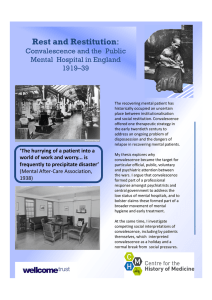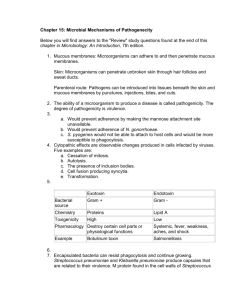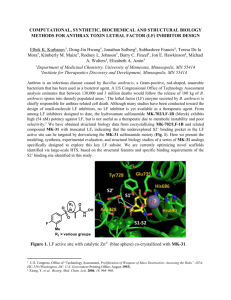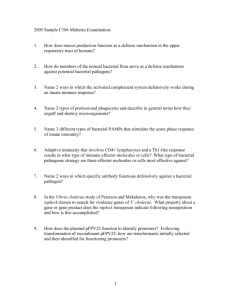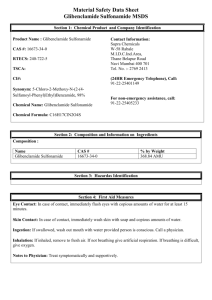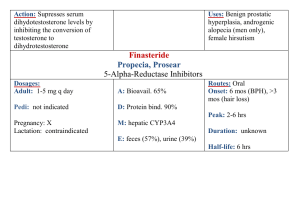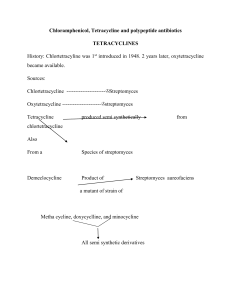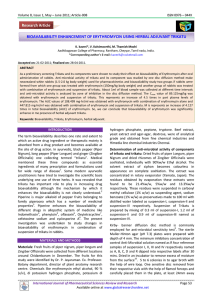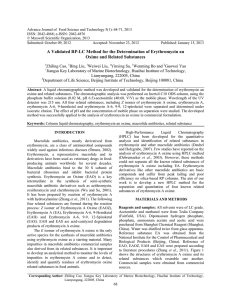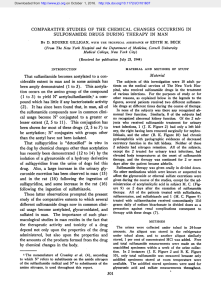Exam #3 2010 - Franklin College
advertisement
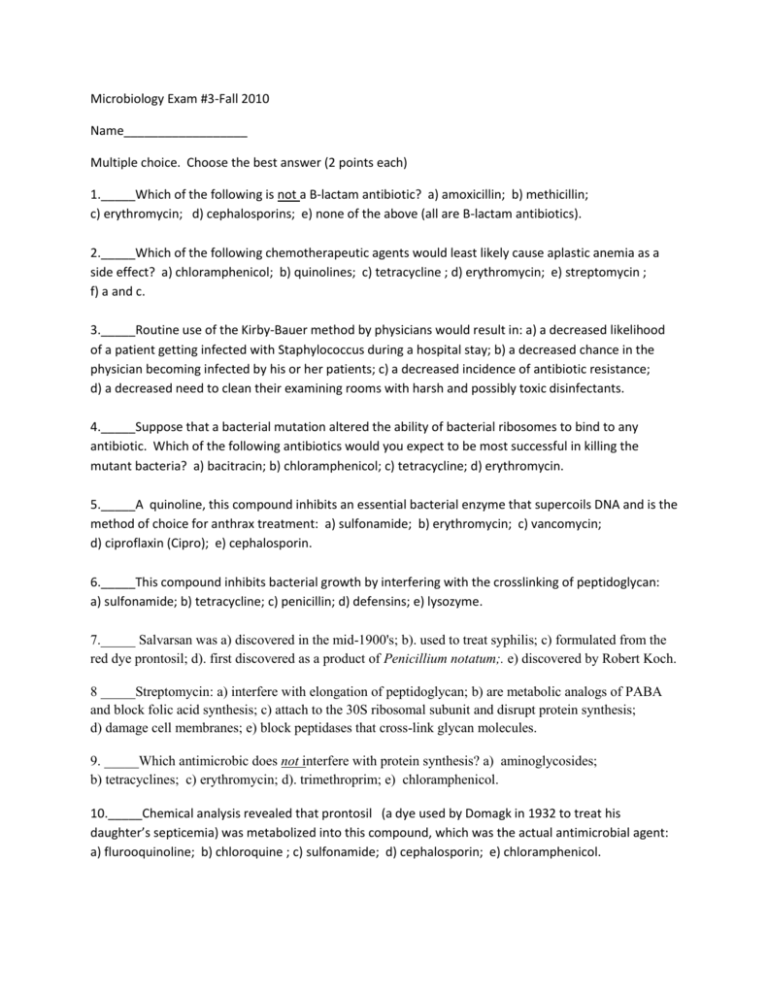
Microbiology Exam #3-Fall 2010 Name__________________ Multiple choice. Choose the best answer (2 points each) 1._____Which of the following is not a B-lactam antibiotic? a) amoxicillin; b) methicillin; c) erythromycin; d) cephalosporins; e) none of the above (all are B-lactam antibiotics). 2._____Which of the following chemotherapeutic agents would least likely cause aplastic anemia as a side effect? a) chloramphenicol; b) quinolines; c) tetracycline ; d) erythromycin; e) streptomycin ; f) a and c. 3._____Routine use of the Kirby-Bauer method by physicians would result in: a) a decreased likelihood of a patient getting infected with Staphylococcus during a hospital stay; b) a decreased chance in the physician becoming infected by his or her patients; c) a decreased incidence of antibiotic resistance; d) a decreased need to clean their examining rooms with harsh and possibly toxic disinfectants. 4._____Suppose that a bacterial mutation altered the ability of bacterial ribosomes to bind to any antibiotic. Which of the following antibiotics would you expect to be most successful in killing the mutant bacteria? a) bacitracin; b) chloramphenicol; c) tetracycline; d) erythromycin. 5._____A quinoline, this compound inhibits an essential bacterial enzyme that supercoils DNA and is the method of choice for anthrax treatment: a) sulfonamide; b) erythromycin; c) vancomycin; d) ciproflaxin (Cipro); e) cephalosporin. 6._____This compound inhibits bacterial growth by interfering with the crosslinking of peptidoglycan: a) sulfonamide; b) tetracycline; c) penicillin; d) defensins; e) lysozyme. 7._____ Salvarsan was a) discovered in the mid-1900's; b). used to treat syphilis; c) formulated from the red dye prontosil; d). first discovered as a product of Penicillium notatum;. e) discovered by Robert Koch. 8 _____Streptomycin: a) interfere with elongation of peptidoglycan; b) are metabolic analogs of PABA and block folic acid synthesis; c) attach to the 30S ribosomal subunit and disrupt protein synthesis; d) damage cell membranes; e) block peptidases that cross-link glycan molecules. 9. _____Which antimicrobic does not interfere with protein synthesis? a) aminoglycosides; b) tetracyclines; c) erythromycin; d). trimethroprim; e) chloramphenicol. 10._____Chemical analysis revealed that prontosil (a dye used by Domagk in 1932 to treat his daughter’s septicemia) was metabolized into this compound, which was the actual antimicrobial agent: a) flurooquinoline; b) chloroquine ; c) sulfonamide; d) cephalosporin; e) chloramphenicol. 11. _____Which of the following is the correct sequence of events in infectious disease? a) incubation; prodromium; invasion; convalescence. b) prodromium ;incubation; convalescence; invasion. c) prodromium ; incubation; invasion; convalescence. d) convalescence; incubation; prodromium; invasion. e) invasion ; incubation; convalescence; prodromium. 12._____ Which of the following statements is the best definition of a pandemic disease? a) it normally occurs in a given geographic area; b) it is a disease that occurs more frequently than usual for a geographical area or group of people; c) it occurs infrequently at no predictable time scattered over a large area or population; d) it is an epidemic that occurs on more than one continent at the same time. 13._____ Virulence factors include: a) exotoxins; b) exoenzymes; c) capsules; d) endotoxins; e) all of the above. 14._____ The specific action of hemolysins is to: a) damage white blood cells; b) cause fever; c) lyse red blood cells; d) activate macrophages e) degrade lecithin 15. _____ A _____infection is acquired in the hospital: a) subclinical; b) systemic; c) secondary; d) nosocomial; e) zoonosis. 16._____ A positive antibody test for HIV would be a ______of an infection: a) sign; b) symptom; c) syndrome; d) sequale. 17._____The virulence factor that causes loss of ions from epithelial cells of the gut, massive dehydration, and “rice water stool”: a) diphtheria toxin; b) cholera toxin; c) tetanospasmin; d) botulism toxin; e) lecithinase. 18._____Which of the following is not associated with an endotoxin? a) gram positive bacteria; b) bacterial cell lysis; c) alteration of permeability of epithelia tissue; d) LPS layer; e) dehydration. 19._____This substance targets nerve cells at the myoneural junction and inhibits them from releasing acetylcholine into the synapse: a) Lipid A; b) tetanus toxin; c) botulism toxin; d) diphtheria toxin; e) nephrotoxin. 20. _____Communicable diseases can spread by several methods. Which is not an example of the direct transmission mode of disease spread? A) Fine droplets sprayed directly upon a person B) Bites from biological vectors C) Contact with contaminated food D) Sexual intercourse E) Placental transfer 21._____Phagocytes of the epidermis are called: a) basophils; b) dendritic cells; c) T-lymphocytes; d) eosinophils; e) natural killer cells. 22._____Which of the following binds iron? a) transferrin; b) siderophlres; c) gastroferritin; d) a and c; e) all of the above. 23. _____ Which of the following granulocytes function primarily as phagocytes? a) eosinophils; b) basophils; c) lymphocytes ; d) macrophages; e) neutrophils. 24._____ Monocytes are ________leukocytes that develop into __________: a) granular, phagocytes; b) agrnaular mast cells; c) agranular, macrophages; d) granular, T-cells. 25._____The second line of defense include all of the following except: a) interferon; b) complement; c) inflammation; d) peristalsis; e) phagocytosis. 26._____Which of the following terms is not associated with B-lymphocytes? a) committed to a specific antigen; b) plasma cells; c) cell-mediated immunity; d) antibody secretion; e) “educated” in the bone marrow. 27._____ An agranulocytic leukocyte that becomes permanently established in the lungs where its chief function is phagocytosis of invaders entering this common portal of entry: a) neutrophil; b) Langerhans cell; c) monocyte; d) T-lymphocyte; e) alveolar macrophage. 28._____ Part of your first line of defense, this chemical is secreted into the small intestine and selectively inhibits the growth of gram (+) bacteria: a) lysozyme; b)hydrogen peroxide; c) sebum; d0 bile salts; e) beta-hemolysin. 29._____ In terms of types of differentiated white blood cells present, these tissues would be the most similar: a) spleen red pulp and the thymus; b) a lymph node and the spleen white pulp; c)the spleen red pulp and the spleen white pulp; d) the liver and the thymus. 30._____These agranulocytes take up the methylene blue portion of the Wright stain and have granules rich in histamines and other inflammatory mediators: a) neutrophils; b) monocytes; c) eosinophils; d) lymphocytes; e) basophils. 31. (4 points each) Agree or disagree with the following statements. In either case, fully defend your position. A. If a methicillin resistant strain of Staph aureus was also found to be resistant to the macrolide antibiotic erythromycin, that would be of major concern to doctors and public health officials. B. Staph aureus has several virulence factors that contribute to its high pathogenicity. C. Zoonotic diseases are non communicable and have a human reservoir. D. If you had two patients, one suffering from a wound and one suffering from aninfection, and just enough blood plasma to treat one patient and just enough blood serum to treat one patient, if you carefully chose who received the plasma and who received the serum you could, theoretically, successfully treat both patients. 32. (8 points) Describe the mechanism by which bacteria can be killed by the antimetabolite drug sulfonamide. Explain how sulfonamide is selective for killing bacteria but not a human host. Why can’t you treat tuberculosis with sulfonamide? 33. (8 points) What is gas gangrene ? How do you contract this condition? Explain how the bacterium Clostridium perfringes is adapted to promote gas gangrene. Relate this to the virulence factors possessed by Clostridium perfringes and the disease symptoms that it produces in gas gangrene. What are the treatment options for gas gangrene? 34. (8 points) Contrast monocytes and B-lymphocytes. Address these issues; how you can distinguish them from one another, where do they differentiate, what type of cells are produced during their differentiation/stimulation process, and the role that each type of differentiated cell plays in the adaptive immune response.
